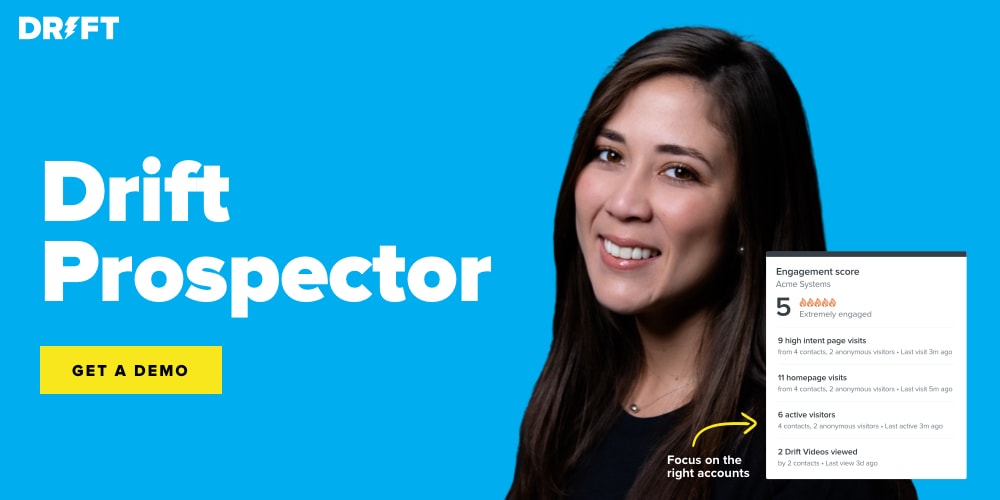You might assume that because SDRs don’t close deals themselves that they don’t need to be masters in Conversational Sales. Sure, SDRs don’t run sales calls. But they are a critical part of the customer experience. And that’s why they need to be great at Conversational Sales.
Because Conversational Sales is all about the customer. Here at Drift, one of our Leadership Principles is to put the customer at the center of everything we do. Forget business-centric processes that make customers jump through hoops to become a lead, only to be bombarded with follow-ups that are anything but personalized.
Instead, we want to treat customers like people, help them find what they’re looking for fast, engage with them on their terms with channels they enjoy using (chat, video, SMS, email, voice), and personalize the experience to their needs. B2C has evolved to do just that (Amazon, Uber, and GrubHub are examples that come to mind), but B2B still has a lot of catching up to do.
As Drift’s Head of Sales Development, I know just how important it is for SDRs to be great at Conversational Sales. Over time, we’ve come up with a number of smart ways to train them.
Why SDRs Need to Master Conversational Sales
I’ll come right out and say it. If SDRs don’t practice Conversational Sales, not only will your pipeline suffer, but you won’t develop talent that can excel later on as a team lead or AE.
That’s because while about 50% of the value of the SDR team is in the meetings we set and the pipeline we build, the other 50% of the value is building the future sellers of your company.
SDRs might only stay in their role for around 12 to 18 months. Use that time to develop the future sellers of your company.
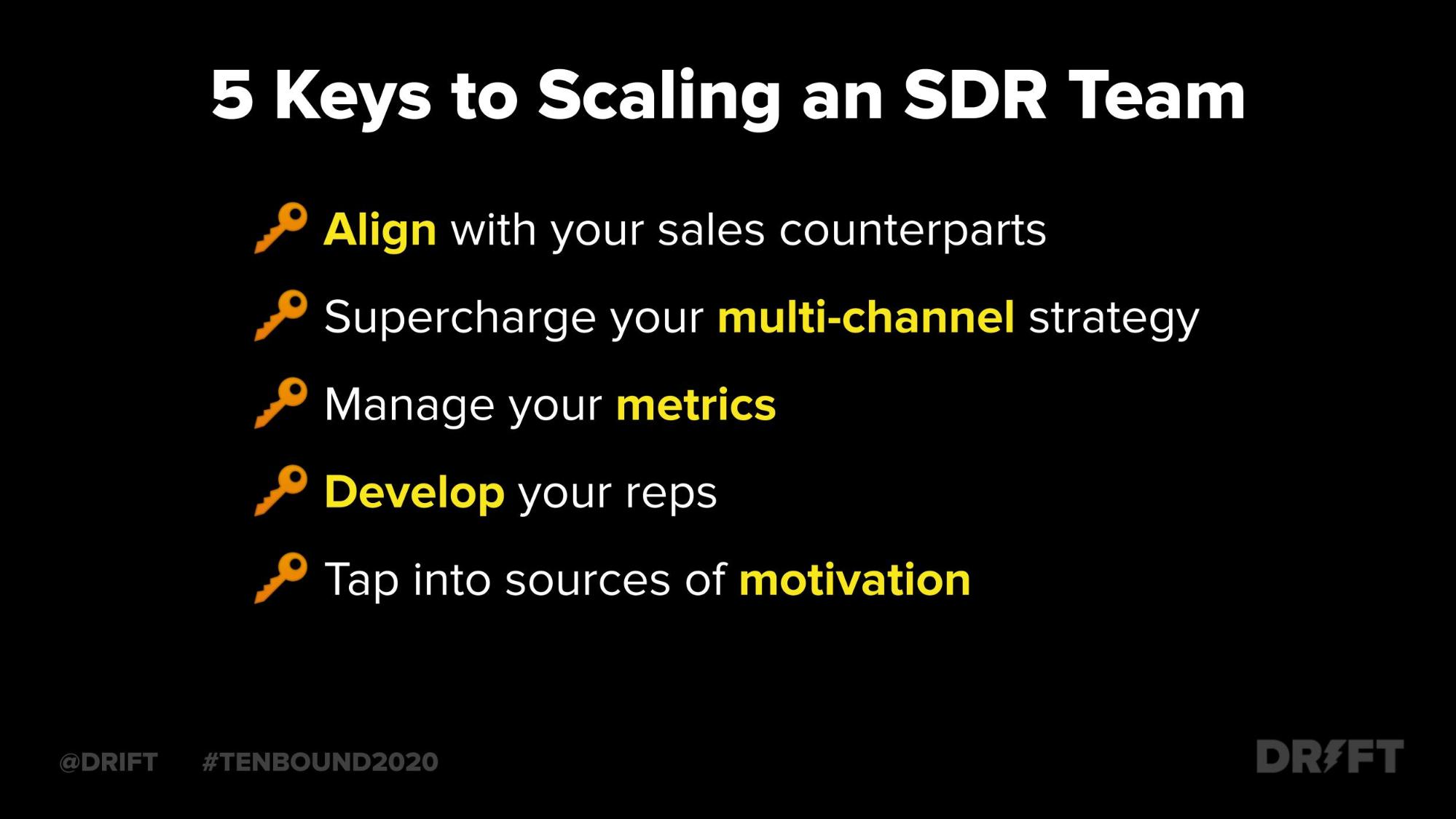
To get them excited about hitting their quota and managing their metrics, it helps to humanize the goals. We make it about doing what’s best for our buyers and furthering their careers.
How We Organize Our SDR Team
There are four smaller teams within our overall SDR team: our conversation development reps (CDRs), outbound SDRs who work with enterprises, outbound SDRs who work with Mid Market, and our inbound SDRs who book calls with new inbound leads. Each of these teams will utilize our Conversational Framework but can be measured on different things.
Our CDRs’ primary goal is to connect our prospects and customers with the right members of our team to get them the information they need, when they need it. They’re the people making sure that all of our prospects, all of our customers, and any visitors on our website have an amazing experience ✨
The most important thing is that the CDRs help website visitors accomplish their goal, whether that’s to get a product or support question answered, find a piece of content, sign up for a webinar or virtual event, research revenue acceleration, or something else.
However, sometimes they do come to us with a challenge that we know we can solve. Then our CDRs switch into SDR-mode and dig into that challenge and work on booking a meeting if that’s the right route.
Consider the different ways that your own SDR teams might utilize conversational selling, depending on the sort of leads or website visitors they work with. You don’t want to give the wrong KPIs to the wrong team, which will end up frustrating not only your SDRs, but your prospects as well.
The Conversational Selling Framework All Our SDRs Use
The simplest way we’ve found to teach conversational sales is with the Conversational Framework:
- Engage
- Understand
- Recommend
With our CDRs, this is easy enough to learn. Engage with website visitors via live chat, understand what they’re looking for, and recommend the right resource.
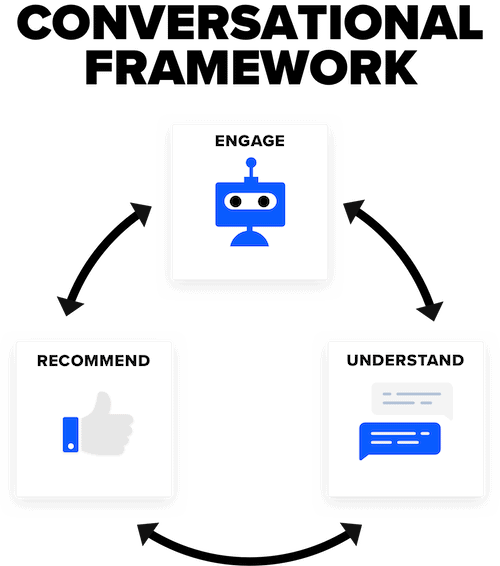
But for our SDRs who do cold calls, this is harder to learn.
We did a training session recently with our outbound SDRs on some of the Sandler Rules. One of the rules we covered was to never answer unasked questions. That’s a pretty difficult rule to follow on a cold call, because your goal is to understand your prospects’ goals and pain points (known and unknown) – and pique their interest in how your solution aligns.
So you first have to understand what information you should be sharing. That’s why we recommend our SDRs start by engaging the prospect with a very brief intro about Drift and then go straight into the Understand phase. We train them to understand the challenges the prospects face through value-based questions, such as asking how they currently engage with target accounts and high-priority prospects.
It’s a difficult thing to master. But once you get it as an SDR, you’ll really see your career take off. This is the part where I circle back around to 50% of the value of your SDR team being in building future sellers.
And as a manager, when you train up your SDRs on Conversational Sales (and Conversational Marketing!), they’ll be well-positioned to exceed their goals for meetings booked – and also get excited about the next stage in their career. What’s not to like about that?
When you do both well and combine Conversational Marketing and Conversational Sales, you get the power of Revenue Acceleration. That’s the real secret to uniting your go-to-market teams.
How We Push SDRs Out of Their Comfort Zone
Sometimes, I’ll have an SDR come to me and say something like, “Hey, I am awesome at writing emails, but I’m not going to pick up the phone.”
Or another SDR might say, “I’m really good on the phone. I just want to make phone calls.”
What if one of your highest priority target prospects doesn’t prefer your favorite engagement channel? If an SDR’s prospect isn’t going to pick up the phone, then they’ve got to be able to engage in other channels as well.
That’s where the importance of a multichannel approach comes in. It’s not just a buzzword. It’s about meeting the buyer where they’re at.
If you rely on one channel, you might only be booking 20% to 30% of your potential meetings.
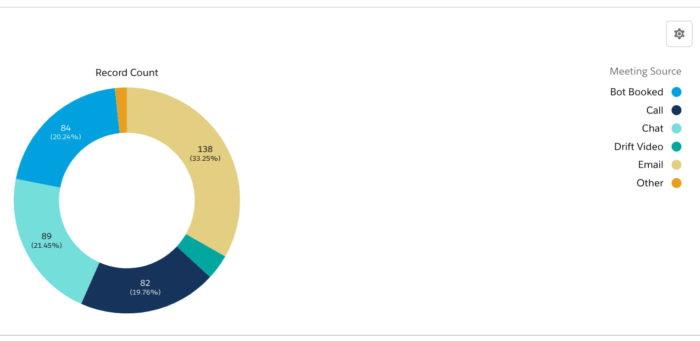
Even though email is such an important outbound channel, it only accounts for a third of all meetings booked by Salesforce customers.
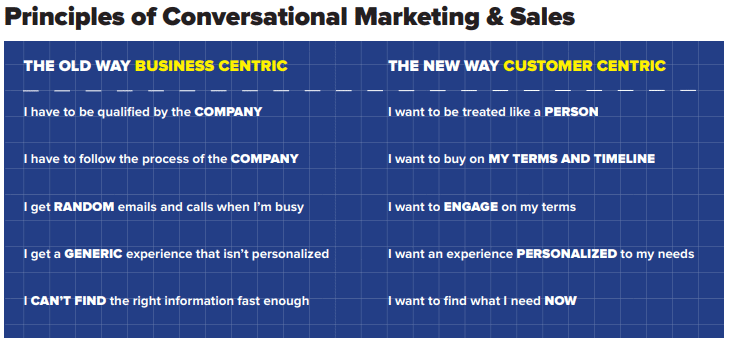
Because the philosophy of Conversational Sales is focused on what the customer needs, then multichannel efforts naturally become a part of that.
When you hire SDRs who really care about the customer, it’s actually easier to push them out of their comfort zone – because it’s not about them. If they want to be of service to the prospects who really need your products and services, then they need to practice using the channels that make them anxious until they become a part of their comfort zone.
Top Ways SDRs Can Prioritize and Personalize Their Work
Want to keep making things all about the buyer?
Then your SDRs need to both prioritize and personalize their efforts.
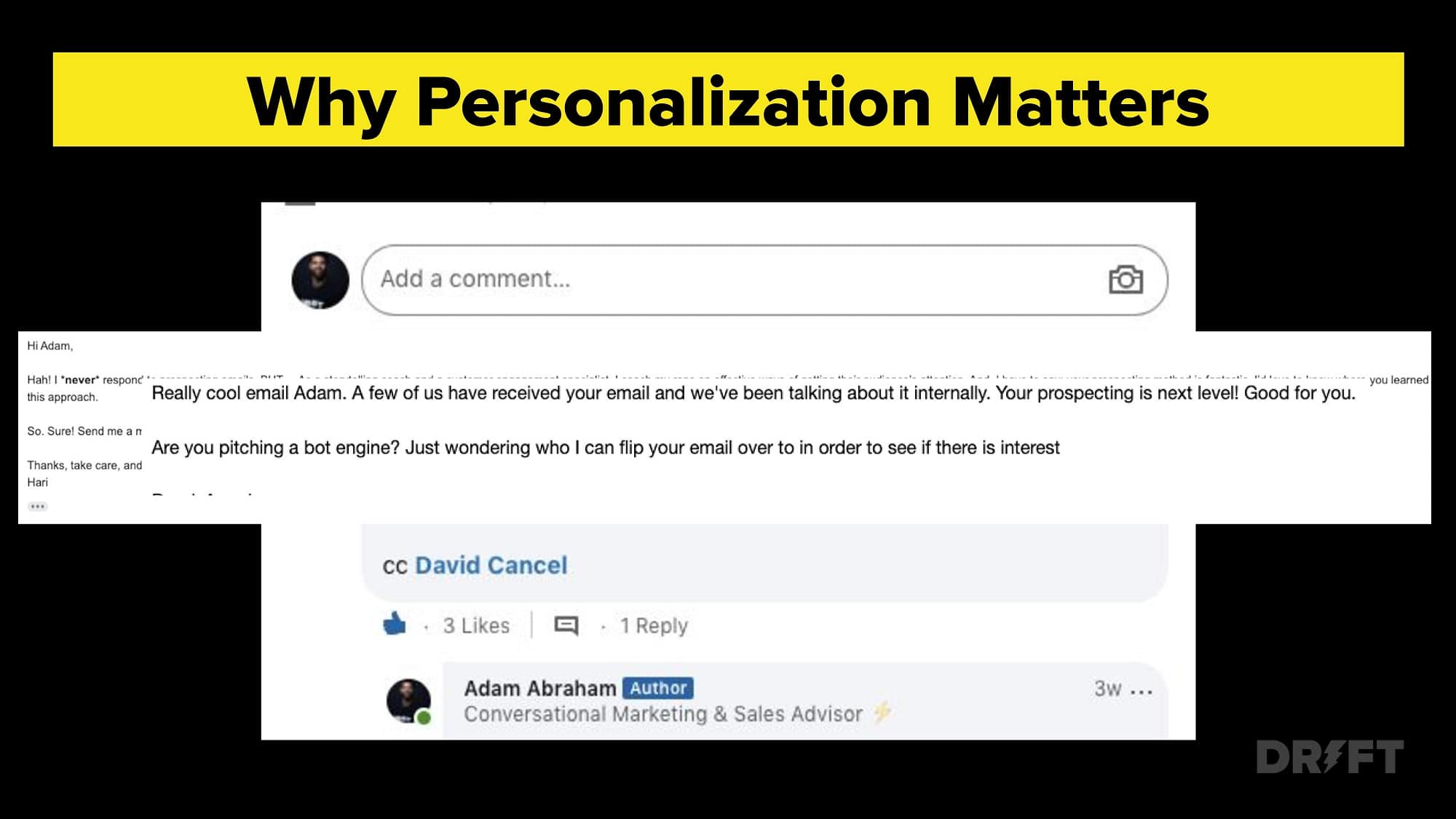
You’re not surprised that personalization is part of conversational sales, but you might be wondering how prioritization is about the buyer.
Sure, prioritizing the right accounts helps your organization, but it also helps your potential customers, because you’re focused on those who need you most or have the most capacity to implement your solution.
Drift Prospector helps our team in a few key ways:
- Account prioritization – Especially for new SDRs, it’s impossible to strategically prioritize their list of 300 target accounts, because they probably don’t have industry experience. We use Drift Prospector to pull all of the information (signs of interest, Salesforce data, company news, etc.) into one place to make faster decisions.
- Finding decision makers – We can actually identify other people that might not have come up in our LinkedIn title searches, because the AI suggests people who can also be decision makers even if they don’t have the standard title we typically look at.
- Social monitoring – We use Drift Prospector to keep track of the updates the company is posting and use this information to make our messaging more personalized.
An Underutilized Technique for Connecting with Target Accounts
Being great at Conversational Sales means acting like a real human. You don’t just have conversations with targets, but with people you know personally, right? Right.
That’s why you need to make sure your SDRs are using their referral network to get a personalized introduction.
When I was leading the SDR team at Outreach, we were one opportunity away from our goal on the last day of the month. The team was just going crazy. Everybody was making dials.
I sent a Snapchat to a group of SDR managers that I’ve worked with in the past and who are in my network. One of them replied back and said that they’d take a meeting. It turned out their new company was a perfect fit.
You might be thinking that you can’t possibly book tons of meetings through Snapchat, and you’d be right. This “underutilized technique” isn’t about Snapchat, it’s about researching your prospects and checking for internal connections.
Here’s how I train my SDR team to do it:
- Check the company’s LinkedIn profile to see if you’re connected with anyone who works there.
- When researching an account, identify 5-8 members of the buying committee based on persona.
- Review each of your prospects’ profiles to search for mutual connections (internal or external).
- Make it easy for your connection to refer you to your prospect by doing the work for them
- Don’t assume they have a strong relationship just because they’re connected on LinkedIn – always ask!
- Be explicit about what you’re asking them to do.
- Write the email for them and ask if they’d feel comfortable sending it and copying you, and of course, let them know they can tweak it to fit their relationship with the prospect.
A little research paired with smart outreach can go a long way.
Structure Your SDR training
I’ve gotten great feedback on my “Learn, Practice, Measure” system from SDRs. Here’s how it works: Each month we select a theme based on a certain metric or behavior we are looking to drive.
We break the theme into 4 sections and focus on one each week. On Mondays, we do a time-wide training and have a subject matter expert instruct, whether it be a Senior SDR, SDR Leader, other Drifters in different departments, or even customers.
On Tuesdays and Thursdays, we run practice drills so they have an opportunity to implement the new skill in a controlled environment. On Wednesdays, we select a small group (usually of new or struggling SDRs), to participate in an intensive feedback session on that particular skill. On Fridays, we do activities to measure knowledge retention.
Here’s a sample of what this looks like:
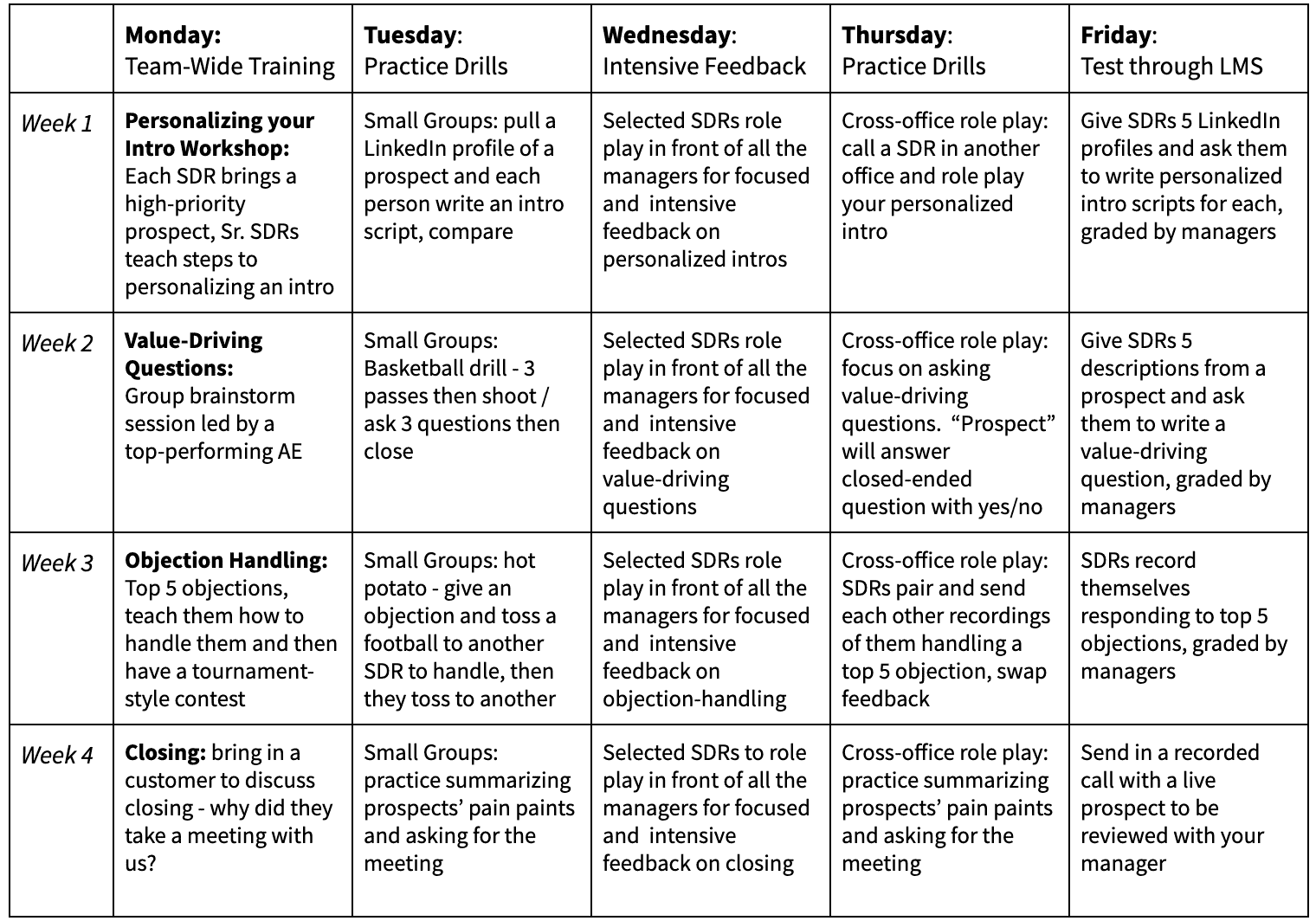
This system ensures time for implementation. Stuffing people’s heads with knowledge never amounts to much, right?
Tap into Career Development for Motivation
SDRs are energetic and excited about their career path in sales. They’re tasting small wins and big wins alike and getting a feel for where the journey can lead.
To motivate SDRs (and keep them motivated), there’s a few different things you need to tap into.
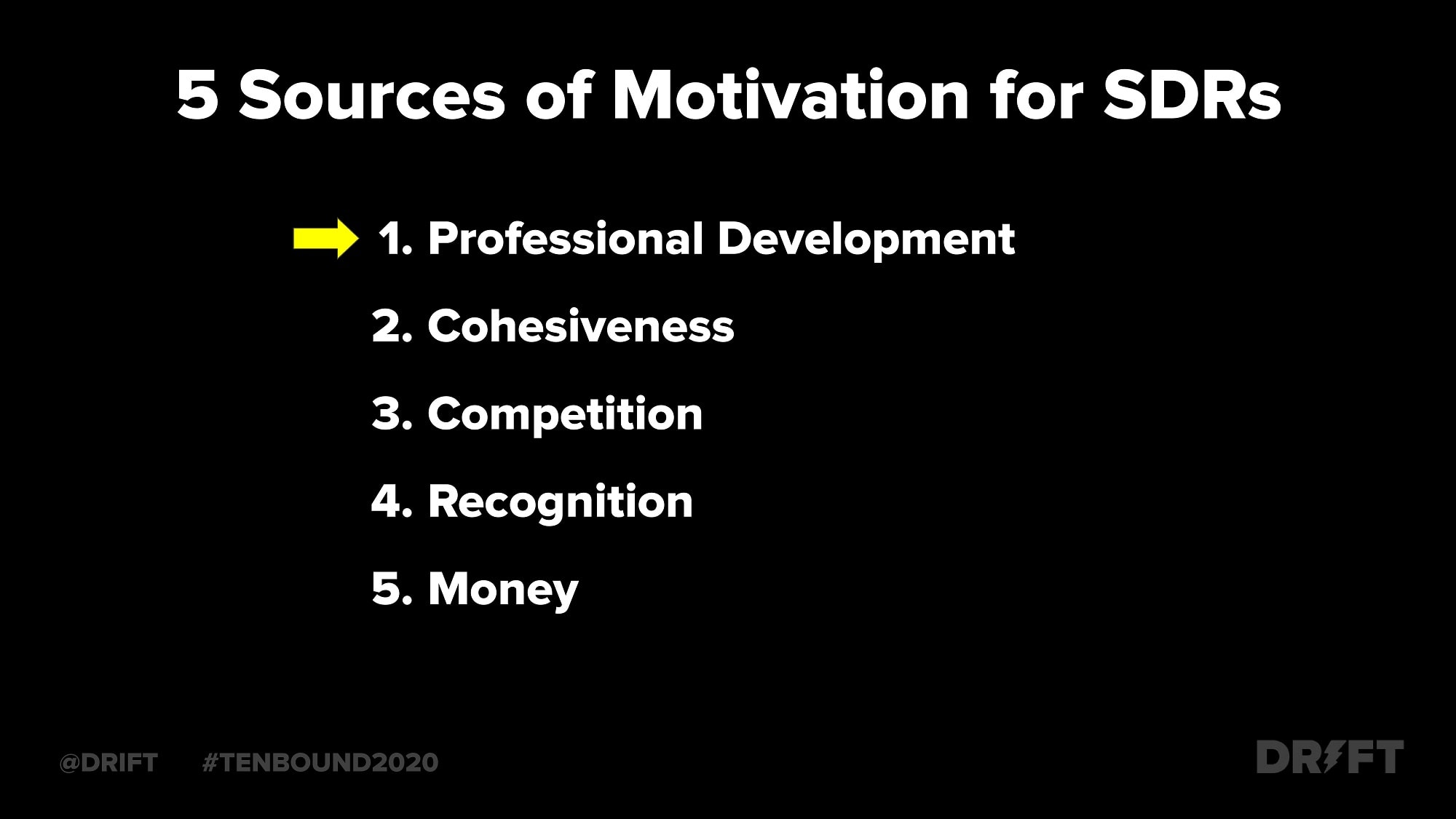
Notice what’s at the top of the list? One of the best ways to keep your SDRs motivated in mastering Conversational Sales is to have an excellent career development program in place.
It’s important to set the stage early that new SDRs will be in the role for 12 to 18 months before they are considered for promotion. This not only ensures a healthy pipeline from the SDR team, but it also helps them understand what needs to happen for them to get to the next level.
One piece of advice? Don’t underestimate the power of a micro-promotion. It satisfies the need for instant gratification, but covers you from risking a premature promotion. Here’s an example of a 12 month set of micro-promotions to implement on the SDR team 👇
![]()
By laying out a career path that manages expectations but also leaves room for individual needs and timelines, you can create clear pathways based on their interests. Plus, it gives you a reference point to check in with your SDRs about what they want to try next.
We’ve found that ongoing training, coaching, and career development are just as effective as the fun prizes and bonuses we award. It may take some more work on your part, but the pay off for your SDRs (and your business) will be well worth it 💰





